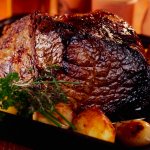
Texas-Style Hindquarter Oven Venison Roast
Blasphemy! Making a “Texas-style” hindquarter venison roast indoors just ain’t right.
Here’s the deal. Not everyone owns an outdoor cooker. Others can’t get past the snow bank to even find the barbecue, but they’d still like to turn a big deer roast into something that’s long on flavor and eats like a pot roast. Plus, there are some days when you just need to stay indoors and you just aren’t sure of how to convert that roast or brisket recipe to your indoor oven.
The process is pretty much the same as cooking it outdoors, and the aroma of the slow-roasted venison will linger in your kitchen long after the meat has been digested.
It’s best prepared in a heavy-duty roasting pan. A Dutch oven with a lid is ideal. Be sure to watch the liquid level in the first part of cooking or else your roast will be dry.
Texas-Style Hindquarter Oven Roast
Ingredients
- 1 3 to 5 pound venison roast, boneless, tied tightly with butcher string or net
- 1 12-ounce beer
- heavy duty foil
The Rub
- ½ cup Kosher salt
- ½ cup coarse ground black pepper
- 2 tbsp paprika
- 2 tbsp garlic powder
- 2 tbsp chili powder
Mop Sauce
- 2 cups water
- ½ cup lemon juice
- 1 tsp kosher salt
- 1 stick butter, melted
- 1 tbsp granulated garlic
- 1 tbsp onion powder
Variety of roasted veggies, potatoes
Instructions
- Prepare rub. Combine rub ingredients in any container, and rub into roast. Wrap the roast snugly with plastic wrap, and place in the refrigerator for 12 to 24 hours.
- Prepare mop sauce. Combine all ingredients in a bowl. Mop sauce will be applied to roast wth a pastry/basting brush or spoon.
- Preheat oven to 400 degrees. Remove roast from refrigerator, and remove plastic wrap. Place in a roasting pan, and brown evenly on all sides, rotating the roast when browned. When browned, add 1 can beer to the pan. Cover with lid or foil, reduce heat to 325 degrees and cook for 1 hour. Remove lid, and apply mop sauce every 15 to 20 minutes until internal temperature reaches 155 degrees. Remove from oven, and set on a large sheet or two of foil. Baste once more, and wrap with the foil. Place the foil-wrapped roast back in the pan (on its own, not sitting in the liquid) and return to the oven. Cook for 2 hours more. Serve with roasted veggies & potatoes, if desired.


Question about the step below. Do I remove the liquid from the pan or place the foil wrapped roast into the cooking liquid for the last 2 hours?
“ Place the foil-wrapped roast back in the pan, and return to the oven. Cook for 2 hours more.”
Remove the roast from oven (without pan sauce), and set on a large sheet or two of foil. Baste once more, and wrap with the foil. The roast will be more tender after an hour or two in the foil.
Hi Scott, a couple of questions,
1. What is the purpose of the butcher string? I have a hind quarter which was cut by a processor and is a flatter cut. Would I still need the string?
2. What final temperature are you looking for when roasting it for 2 hours?
1. Once the HQ is trimmed and the muscles aren’t as “attached” as before trimming, tying with with string puts the roast in a uniform shape, which will cool much more evenly.
2. 130 – 135 internal temp for med-rare. You can cook it longer, but I don’t.
Thank you Scott! So far your recipes haven’t steered me wrong so I will follow you lead. Thank you!
Hi – I’m excited to cook this. Question – in the initial roasting, it states to cook until internal temperature is at 155 before taking it out and cooking for an additional two hours in foil..I’m a bit confused by this. If the optimal end temp is 130, how am I initially letting it get to 155?
You are 100% correct if you plan to slice it while med-rare for plating or sandwiches. As per the description, this will be more like a pot roast.
Scott, if you cook it initially until it’s 155 degrees before you wrap it, it’s already well done in my opinion. Is the 155 a misprint?
Think pulled pork or pot roast.
[…] Get the recipe at: The Sporting Chef […]